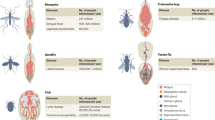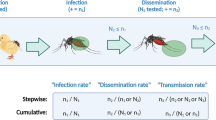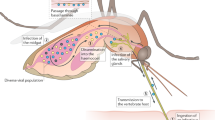Abstract
Diseases that are transmitted by arthropods cause severe morbidity and mortality throughout the world. The burden of many of these diseases is borne largely by developing countries. Advances in vector genomics offer new promise for the control of arthropod vectors of disease. Radical changes in vector-biology research are required if scientists are to exploit genomic data and implement changes in public health
This is a preview of subscription content, access via your institution
Access options
Subscribe to this journal
Receive 12 print issues and online access
$209.00 per year
only $17.42 per issue
Buy this article
- Purchase on Springer Link
- Instant access to full article PDF
Prices may be subject to local taxes which are calculated during checkout



Similar content being viewed by others
References
World Health Organization. The World Health Report 2002, Reducing Risks, Promoting Healthy Life (World Health Organization, Geneva, 2002).
World Health Organization. The World Health Report 2004, Changing History (World Health Organization, Geneva, 2004).
Holt, R. A. et al. The genome sequence of the malaria mosquito Anopheles gambiae. Science 298, 129–149 (2002).
Butler, D. African labs win major role in tsetse-fly genome project. Nature 427, 384 (2004).
Jasinskiene, N. et al. Stable transformation of the yellow fever mosquito, Aedes aegypti, with the Hermes element from the housefly. Proc. Natl Acad. Sci. USA 95, 3743–3747 (1998).
Coates, C. J., Jasinskiene, N., Miyashiro, L. & James, A. A. Mariner transposition and transformation of the yellow fever mosquito, Aedes aegypti. Proc. Natl Acad. Sci. USA 95, 3748–3751 (1998).
Catteruccia, F. et al. Stable germline transformation of the malaria mosquito Anopheles stephensi. Nature 405, 959–962 (2000).
Dimopoulos, G. et al. Genome expression analysis of Anopheles gambiae: responses to injury, bacterial challenge, and malaria infection. Proc. Natl Acad. Sci. USA 99, 8814–8819 (2002).
Coluzzi, M., Sabatini, A., della Torre, A., Di Deco, M. A. & Petrarca, V. A polytene chromosome analysis of the Anopheles gambiae species complex. Science 298, 1415–1418 (2002).
della Torre, A. et al. Speciation within Anopheles gambiae — the glass is half full. Science 298, 115–117 (2002).
Toure, Y. et al. The distribution and inversion polymorphism of chromosomally recognized taxa of the Anopheles gambiae complex in Mali, West Africa. Parassitologia 40, 477–511 (1998).
Ito, J., Ghosh, A., Moreira, L. A., Wimmer, E. A. & Jacobs-Lorena, M. Transgenic anopheline mosquitoes impaired in transmission of a malaria parasite. Nature 417, 452–455 (2002).
Hallem, E. A., Fox, N. A., Zweibel, L. J. & Carlson, J. R. Olfaction: mosquito receptor for human-sweat odorant. Nature 427, 212–213 (2004).
Osta, M. A., Christophides, G. K. & Kafatos, F. C. Effects of mosquito genes on Plasmodium development. Science 303, 2030–2032 (2004).
Scott, T. W., Takken, W., Knols, B. G. & Boete, C. The ecology of genetically modified mosquitoes. Science 298, 117–119 (2002).
James, A. A. Engineering mosquito resistance to malaria parasites: the avian malaria model. Insect Biochem. Mol. Biol. 32, 1317–1323 (2002).
Hill, C. A. et al. G protein-coupled receptors in the genome of Anopheles gambiae. Science 298, 176–178 (2002).
Fox, A. N., Pitts, R. J., Robertson, H. M., Carlson, J. R. & Zwiebel, L. J. Proc. Natl Acad. Sci. USA 98, 14693–14697 (2001).
Blandin, S. et al. Reverse genetics in the mosquito Anopheles gambiae: targeted disruption of the defensin gene. EMBO Rep. 3, 852–856 (2002).
Author information
Authors and Affiliations
Corresponding author
Ethics declarations
Competing interests
The authors declare no competing financial interests.
Related links
Related links
DATABASES
Entrez
Infectious Disease Information
FURTHER INFORMATION
Rights and permissions
About this article
Cite this article
Hill, C., Kafatos, F., Stansfield, S. et al. Arthropod-borne diseases: vector control in the genomics era. Nat Rev Microbiol 3, 262–268 (2005). https://doi.org/10.1038/nrmicro1101
Published:
Issue Date:
DOI: https://doi.org/10.1038/nrmicro1101
This article is cited by
-
The Microbiota of Ixodes ricinus and Dermacentor reticulatus Ticks Collected from a Highly Populated City of Eastern Europe
Microbial Ecology (2022)
-
Knowledge, attitudes, and practices regarding vector-borne diseases in central Mexico
Journal of Ethnobiology and Ethnomedicine (2021)
-
Molecular characterization of RNase III protein of Asaia sp. for developing a robust RNAi-based paratransgensis tool to affect the sexual life-cycle of Plasmodium or Anopheles fitness
Parasites & Vectors (2020)
-
RNA interference-mediated knockdown of 3, 4-dihydroxyphenylacetaldehyde synthase affects larval development and adult survival in the mosquito Aedes aegypti
Parasites & Vectors (2019)
-
Characterization of tick organic anion transporting polypeptides (OATPs) upon bacterial and viral infections
Parasites & Vectors (2018)



